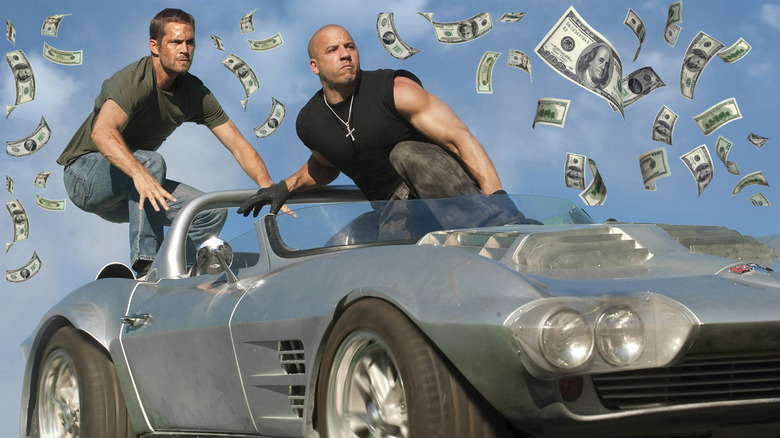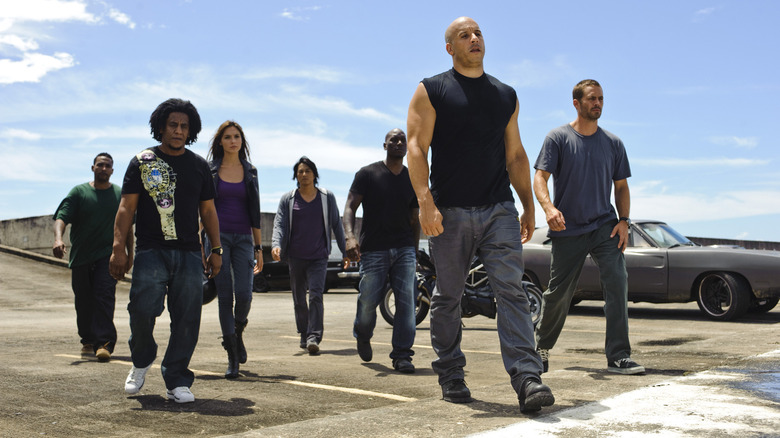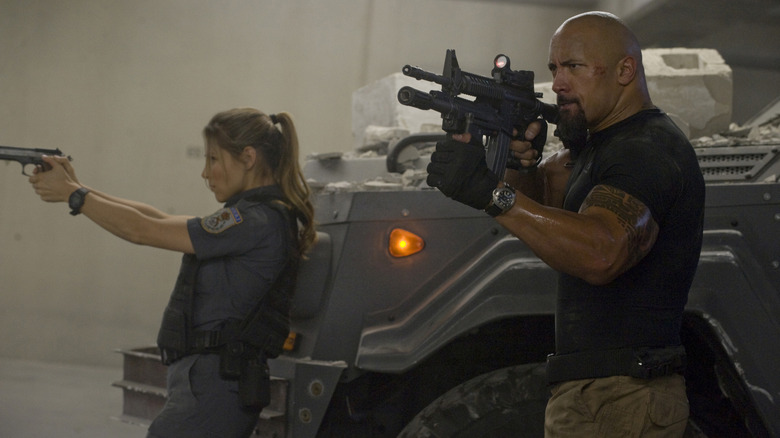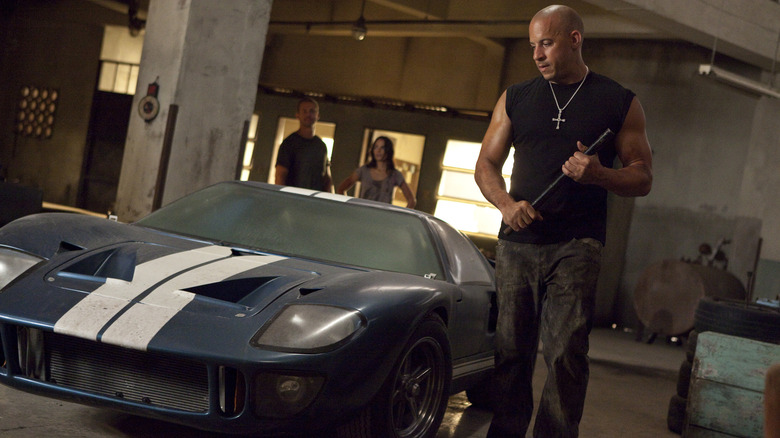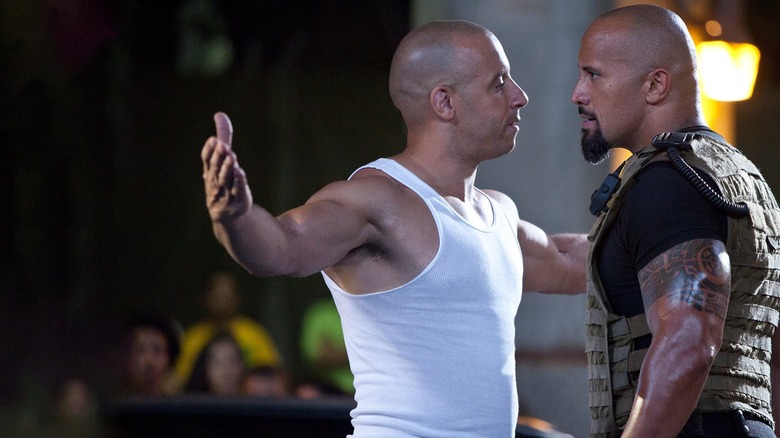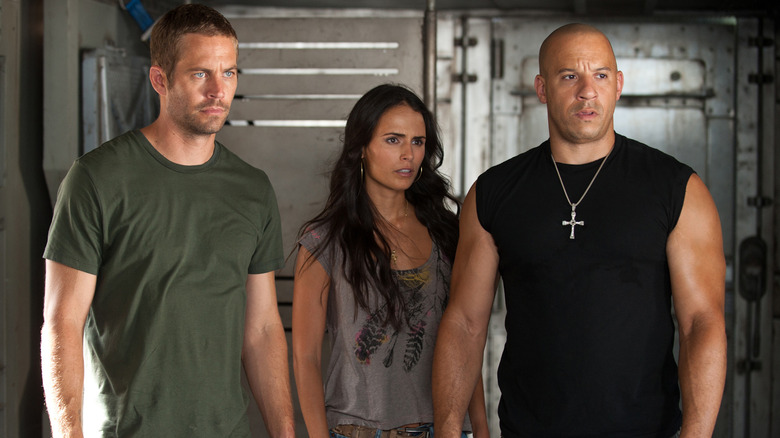Tales From The Box Office: Fast Five Was The Dawn Of A New Era For Fast & Furious
(Welcome to Tales from the Box Office, our column that examines box office miracles, disasters, and everything in between, as well as what we can learn from them.)
Despite its humble beginnings as a thinly-veiled remake of "Point Break," the "Fast & Furious" films have gone on to find tremendous success over the last 20 years at the box office. The series evolved from street racing and stealing DVD players to a full-on, global action series with a staggeringly huge audience. So much so that "Fast X," the tenth film in the main series (not counting "Hobbs & Shaw") has just hit theaters and figures to be one of the biggest global hits of the year. Nearly $7 billion worth of ticket sales later, we've still got at least one more film to look forward to before Dominic Toretto and his Fast Family call it quits.
But when did things change, and why did they change so dramatically? While it was something of a slow shift, the true point of no return was 2011's "Fast Five," which upped the stakes beyond what anyone would have previously thought possible. Director Justin Lin managed to pull arguably the most successful cinematic pivot in history, giving Universal Pictures a wildly unlikely multi-billion-dollar franchise in the process.
In honor of the release of "Fast X," we're looking back at "Fast Five," how it came to be, how Lin and Diesel decided to lay the groundwork for what the franchise became, what happened when the movie hit theaters, and what lessons we can learn from it more than a decade later. Let's dig in, shall we?
The movie: Fast Five
It's easy to take for granted now, after the craziness of later entries such as "The Fate of the Furious," but even though 2009's "Fast & Furious" (which largely restored the status quo after "Tokyo Drift"), this was mostly a series of films about street racing and crime of a certain level. Justin Lin first entered the picture with "Tokyo Drift," but he had the vision to take the series in a bold, new, broadly audience-friendly direction.
"The question putting 'Fast Five' and 'Fast Six' together for us was: Can we take it out of being a pure car culture movie and into being a true action franchise in the spirit of those great heist films made 10 or 15 years ago?" Universal chairman Adam Fogelson said to Deadline ahead of the release of "Fast Five." That was the central question that changed the game, and Lin proved that he was exactly the right man for the job. While "Fast & Furious" is not viewed as one of the finer entries in the series, it did set the table for what is widely regarded as not only the best of the bunch but perhaps one of the greatest action movies of the 21st century.
The fifth entry was announced officially by Universal in early 2010 after "Fast & Furious" became Universal's biggest movie of 2009, taking in $359.3 million worldwide. An almost laughably small sum compared to what subsequent entries pulled in, but that tells you just how far we've come. The sixth film was already being planned at this time. That's key, as it demonstrated true vision arguably for the first time in the history of the series beyond the "one movie at a time" approach.
Expanding the family
"The thing that I appreciate about this franchise, and the studio, is that they've never asked for just recycling the same thing over, and over again. By virtue of that, I feel like this franchise has been able to grow, and evolve, and mature," Lin said in a featurette included with the home video release of the film. "If you're talking about family, wouldn't it be great to bring everybody from every 'Fast & Furious' back?" That's exactly what the filmmaker did.
"Fast Five" sees Vin Diesel's Dom, Paul Walker's Brian, and the rest of the gang being hunted across Rio de Janeiro by a relentless federal agent named Hobbs, after finding themselves on the run for breaking Dom out of jail. Looking for a way out, they plot an insane $100 million heist to free themselves for good. But Hobbs is on their tail the whole way, and the crooked businessman from whom they're stealing from isn't going to give his money up without a fight.
So sure, the characters from the previous four movies were going to unite, but who were they going to unite against? Enter The Rock. The wrestler-turned-actor also known as Dwayne Johnson was hitting the peak of his career at this time, and had even earned a reputation as "franchise Viagra" thanks to what he did for "G.I Joe" and others at the time. But casting him as Hobbs was a stroke of pure genius, bringing the right star, at the right time, into exactly the right situation. Speaking ahead of the film's release, Johnson had this to say:
"I wanted to take that character and pit him against Vin Diesel's character who, within that franchise, has a beloved following and is a beloved antihero. The notion of me working with Vin on screen was always interesting to me, but not as partners. I thought it was important for us to go at it. That's what I wanted to see."
Upping the action
Universal and Lin both understood that if they wanted to expand the scope of what these movies could be, it meant going bigger. That, first of all, meant a legitimate blockbuster budget of $125 million, compared to the $85 million spent on the previous two entries (the original had been made a decade earlier for a very reasonable $38 million). Most audiences would probably agree that it was money well spent, as "Fast Five" has some truly outstanding action sequences, including the train heist in the opening act.
Most infamously, the third act involves Dom and Brian dragging a multi-ton safe through the streets of Rio, causing more collateral damage than one can possibly comprehend for the sake of our collective entertainment. This was going well beyond the scope of what these movies had attempted previously, but that also helped attract a wider range of viewers who had previously written these off as "car movies."
Rather remarkably, the vault scene was largely accomplished through practical means. Stunt coordinator Jack Gill explained in an interview with Screen Rant as the film was hitting theaters just how much work went into pulling that wild sequence off.
"There was never once a CG vault. We had 7 different vaults that each served a different purpose. We had 4 week of prep for the scene, storyboarded everything and every camera angle was pre-determined. The tumbling safe on the first turn was real, not CGI. It was much more violent than we even expected."
All of that hard work paid off, as audiences turned up in droves to see what Lin and his team cooked up. They wanted to smell what The Rock was cooking alongside Dom Toretto. They wanted the new and improved "Fast & Furious" franchise.
The financial journey
Universal Pictures decided to release "Fast Five" on April 29, 2011, in the pre-summer window that can often be quite lucrative for the right movie. In this case, Universal had the right movie. It certainly helps that the reviews were strong, with the film still ranking as the second-best-reviewed in the history of the series behind only "Furious 7." That positive buzz, coupled with The Rock of it all, made for a perfect storm that led to one heck of a run at the box office.
"Fast Five" easily debuted at number one domestically, taking in a stellar $86.1 million. Most other studios steered clear, with "Prom" and "Hoodwinked 2" serving as the only other meaningful new releases that weekend. It wasn't even close, as "Rio" took the number two spot that weekend with $14.7 million. The only real issue was "Thor," which opened the following weekend, leading to a pretty significant 62.4% drop for "Fast Five," making for a $32.4 million second weekend. Even so, the film was a runaway hit that finished with $209.8 million domestically and a whopping $416.3 million internationally. This series became a true monster overseas, which is key. All told it earned $626.1 million worldwide, ranking as the seventh biggest movie of 2011 overall.
Dom and the gang were on another plane of existence now, and ensuing entries would only increase the size of the franchise's global audience. "Fast & Furious 6" did $789.3 million worldwide in 2013, with "Furious 7" becoming a downright global phenomenon in 2015, raking in $1.51 billion, ranking as one of the highest-grossing films in history. With "Fast X," the series will cross $7 billion worldwide, and the turning point that allowed this all to happen was, without question, "Fast Five."
The lessons contained within
Any time breakout success like this happens, it feels like there is an element of luck. Making any movie is hard; making a movie of this size is a miracle. That having been said, no amount of luck can account for sustained success like this franchise has had since "Fast Five" arrived more than a decade ago. Bigger doesn't always mean better but, in this case, that old adage held true. Yet the heart of it all lies deeper than that, and it's a lesson other long-running franchises would do well to learn.
It all goes back to Lin saying that Universal never had any interest in just recycling what came before. And, say whatever you will of the "Fast" movies since Paul Walker's tragic passing, but audiences are still turning up in droves to see them. The fact that the studio didn't just keep making street racing movies around the world after "Tokyo Drift" says so much. They let this series evolve, somewhat naturally, into something well beyond what was originally intended. In letting the series grow, the audience grew with it. It's downright remarkable. It certainly doesn't hurt that "Fast Five," "Fast & Furious 6," and "Furious 7" makes for one heck of an action trilogy.
Again, none of that happens if Universal plays it safe, or if Lin decides to play it safe. Studios can and should be willing to left franchises change. Sure, it's easier said than done, and this is a pretty remarkable example of things going well. But, inevitably, audiences will turn away if too much of the same happens over a long enough period of time. Let the movies grow, and the audience can grow with them, rather than shrink.
